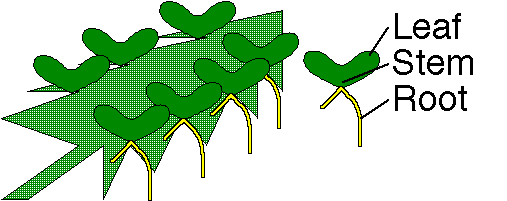

In plants such as Bryophyllum (also known as "mother of thousands") or the piggyback plant, the leaf supports development of a tiny shoot buds. These buds may begin to form roots at their base. As these shoots break off from the original leaf, they fall onto the ground and take root.
Cytokinins accumulating at the leaf margins stimulate cell division in the notches to produce these adventitious shoots.

For plants such as onions, garlic, tulip, daffodil, and hyacinth, the bulb is the unit of vegetative propagation. The stem is shortened down to a disc, often called the basal plate from which roots arise around the edge. The leaf bases are attached to the upper surface of the stem. The axillary buds always found at the node (where the leaves attach) can develop into new bulbs in subsequent years.
Thus, if you plant one daffodil bulb, a few years later you will have several bulbs in that place competing with each other for nutrients, water, and sun exposure. The flowering may be reduced as years go by unless the gardener digs up the competing bulbs and separates them in late summer. Sometimes you will discover that one onion is really "two" bulbs when you look inside.
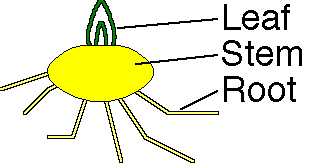
Gladiolus and crocus "bulbs" are really not anything like an onion inside. These species have corms. The corm is essentially a basal plate without the leaf bases. The roots still originate around the edge of the disc-like corm and on the convex (lower) surface. The apical and axillary buds of the shoot system originate on the almost concave (upper) surface. Each of these will make a new corm for the next year.
Again, this proliferation of corms on the upper surface of the original corm, results in a clump of corms competing with each other. So, if your crocus corms stop flowering after a few years, you simply need to dig them up in late summer and spread them out for next year.
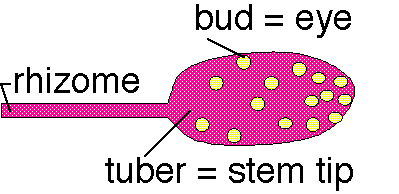
Potato (Solanum tuberosum) and Jerusalem Artichoke (Helianthus tuberosus) both have tubers. In late summer, underground leafless stems called rhizomes penetrate the upper layers of soil around the base of the original plant. In fall, the tips of the rhizomes enlarge to form a swollen object called a tuber.
Since this is a stem tip, it is not a surprise that it has an apical and many axillary buds all over its surface. These are called "eyes" in common language. Each one of these buds can develop into a new plant next year. In fact a whole row of potato plants can be started from just one good tuber.
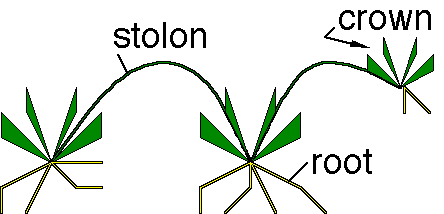
Strawberries produce an above-ground branch (shoot) with very tiny leaves. These almost-leafless branches are called stolons. These develop a tiny plantlet, the crown at the tip (apical bud). This crown grows and weighs down the end of the stolon. As the crown bends the stolon toward the earth, it accumulates auxin (because of the horizontal position) and roots begin to develop. When it touches down on the ground, the roots penetrate and root the crown into the soil.
Since each plant may make a dozen of these crowns, you do not need to buy a huge number of strawberry plants to make a good strawberry patch. Within a year or so you can have a vast number of plants to move around in your patch.
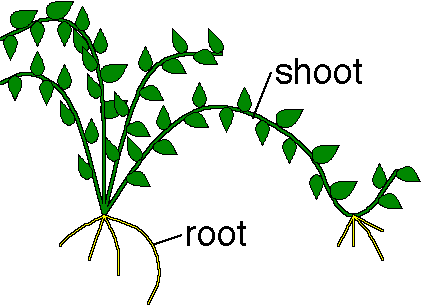
Black Raspberry and blackberry plants (among many other plants) can spread by having arching shoots that ultimately touch-down onto the soil. The rubbing of the stem on the soil and the horizontal position of the stem along the soil surface cause auxins to build up there. The auxins induce root formation.
The developing roots produce lots of cytokinins. These chemicals induce more shoot formation. The tangle of arching shoots and tip rooting result in a very dense "briar patch." If you add prickles along the stem, this briar patch can be a severe obstacle for passage.
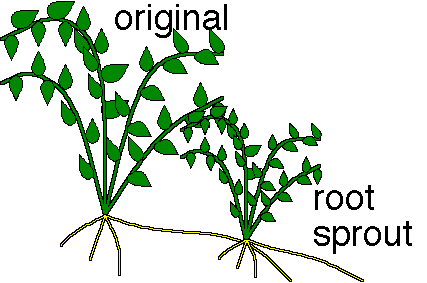
Red Raspberries and many (most) shrubs can produce root sprouts. The roots of most plants produce cytokinins. As these accumulate in the roots, the cytokinins induce shoot formation. Near the base of the shrub, a new shoot will begin to grow. The new shoot is called a root sprout or "sucker." A large number of these growing up together can make quite a thicket. In wetlands of Connecticut, the spicebush (Lindera benzoin) and sweet pepper bush (Clethra alnifolia) propagate naturally this way.
Go back to Ross Koning's Home Page.
Send comments and bug reports to Ross Koning at koning@ecsu.ctstateu.edu.
View the Standard Disclaimer.